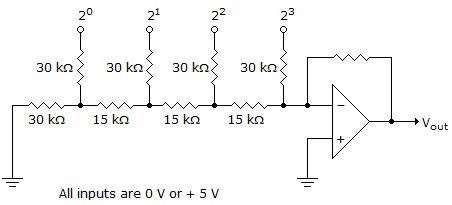Digital Electronics - Interfacing to the Analog World
Exercise : Interfacing to the Analog World - General Questions
- Interfacing to the Analog World - General Questions
- Interfacing to the Analog World - True or False
- Interfacing to the Analog World - Filling the Blanks
46.
What is the linearity of a D/A converter?
47.
Referring to the given figure, what should the display on the scope look like if the A/D converter is working properly?

48.
What is the acquisition time of the AD1154 sample-and-hold IC?
49.
What type of DAC is shown below?

50.
What is the disadvantage to using a counter-ramp type ADC?
Quick links
Quantitative Aptitude
Verbal (English)
Reasoning
Programming
Interview
Placement Papers
 s
s